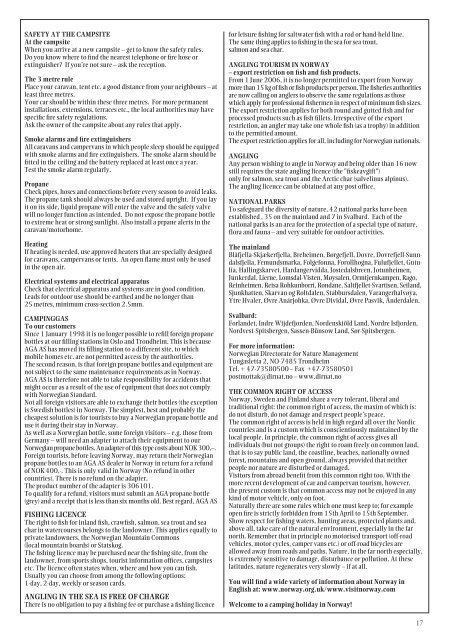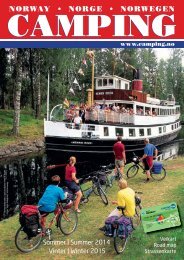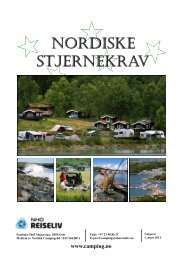Norwegian Campingguide - Norsk Campingguide
Norwegian Campingguide - Norsk Campingguide
Norwegian Campingguide - Norsk Campingguide
Create successful ePaper yourself
Turn your PDF publications into a flip-book with our unique Google optimized e-Paper software.
SAFETY AT THE CAMPSITE<br />
At the campsite<br />
When you arrive at a new campsite – get to know the safety rules.<br />
Do you know where to find the nearest telephone or fire hose or<br />
extinguisher? If you’re not sure – ask the reception.<br />
The 3 metre rule<br />
Place your caravan, tent etc. a good distance from your neighbours – at<br />
least three metres.<br />
Your car should be within these three metres. For more permanent<br />
installations, extensions, terraces etc., the local authorities may have<br />
specific fire safety regulations.<br />
Ask the owner of the campsite about any rules that apply.<br />
Smoke alarms and fire extinguishers<br />
All caravans and campervans in which people sleep should be equipped<br />
with smoke alarms and fire extinguishers. The smoke alarm should be<br />
fitted in the ceiling and the battery replaced at least once a year.<br />
Test the smoke alarm regularly.<br />
Propane<br />
Check pipes, hoses and connections before every season to avoid leaks.<br />
The propane tank should always be used and stored upright. If you lay<br />
it on its side, liquid propane will enter the valve and the safety valve<br />
will no longer function as intended. Do not expose the propane bottle<br />
to extreme heat or strong sunlight. Also install a prpane alerts in the<br />
caravan/motorhome.<br />
Heating<br />
If heating is needed, use approved heaters that are specially designed<br />
for caravans, campervans or tents. An open flame must only be used<br />
in the open air.<br />
Electrical systems and electrical apparatus<br />
Check that electrical apparatus and systems are in good condition.<br />
Leads for outdoor use should be earthed and be no longer than<br />
25 metres, minimum cross-section 2.5mm.<br />
CAMPINGGAS<br />
To our customers<br />
Since 1 January 1998 it is no longer possible to refill foreign propane<br />
bottles at our filling stations in Oslo and Trondheim. This is because<br />
AGA AS has moved its filling station to a different site, to which<br />
mobile homes etc. are not permitted access by the authorities.<br />
The second reason, is that foreign propane bottles and equipment are<br />
not subject to the same maintenance requirements as in Norway.<br />
AGA AS is therefore not able to take responsibility for accidents that<br />
might occur as a result of the use of equipment that does not comply<br />
with <strong>Norwegian</strong> Standard.<br />
Not all foreign visitors are able to exchange their bottles (the exception<br />
is Swedish bottles) in Norway. The simplest, best and probably the<br />
cheapest solution is for tourists to buy a <strong>Norwegian</strong> propane bottle and<br />
use it during their stay in Norway.<br />
As well as a <strong>Norwegian</strong> bottle, some foreign visitors – e.g. those from<br />
Germany – will need an adapter to attach their equipment to our<br />
<strong>Norwegian</strong> propane bottles. An adapter of this type costs about NOK 300,–.<br />
Foreign tourists, before leaving Norway, may return their <strong>Norwegian</strong><br />
propane bottles to an AGA AS dealer in Norway in return for a refund<br />
of NOK 400,-. This is only valid in Norway (No refund in other<br />
countries). There is no refund on the adapter.<br />
The product number of the adapter is 306101.<br />
To qualify for a refund, visitors must submit an AGA propane bottle<br />
(grey) and a receipt that is less than six months old. Best regard, AGA AS<br />
FISHING LICENCE<br />
The right to fish for inland fish, crawfish, salmon, sea trout and sea<br />
char in watercourses belongs to the landowner. This applies equally to<br />
private landowners, the <strong>Norwegian</strong> Mountain Commons<br />
(local mountain boards) or Statskog.<br />
The fishing licence may be purchased near the fishing site, from the<br />
landowner, from sports shops, tourist information offices, campsites<br />
etc. The licence often states when, where and how you can fish.<br />
Usually you can choose from among the following options:<br />
1-day, 2-day, weekly or season cards.<br />
ANGLING IN THE SEA IS FREE OF CHARGE<br />
There is no obligation to pay a fishing fee or purchase a fishing licence<br />
for leisure fishing for saltwater fish with a rod or hand-held line.<br />
The same thing applies to fishing in the sea for sea trout,<br />
salmon and sea char.<br />
ANGLING TOURISM IN NORWAY<br />
– export restriction on fish and fish products.<br />
From 1 June 2006, it is no longer permitted to export from Norway<br />
more than 15 kg of fish or fish products per person. The fisheries authorities<br />
are now calling on anglers to observe the same regulations as those<br />
which apply for professional fishermen in respect of minimum fish sizes.<br />
The export restriction applies for both round and gutted fish and for<br />
processed products such as fish fillets. Irrespective of the export<br />
restriction, an angler may take one whole fish (as a trophy) in addition<br />
to the permitted amount.<br />
The export restriction applies for all, including for <strong>Norwegian</strong> nationals.<br />
ANGLING<br />
Any person wishing to angle in Norway and being older than 16 now<br />
still requires the state angling licence (the "fiskeavgift")<br />
only for salmon, sea trout and the Arctic char (salvelinus alpinus).<br />
The angling licence can be obtained at any post office.<br />
NATIONAL PARKS<br />
To safeguard the diversity of nature, 42 national parks have been<br />
established , 35 on the mainland and 7 in Svalbard. Each of the<br />
national parks is an area for the protection of a special type of nature,<br />
flora and fauna – and very suitable for outdoor activities.<br />
The mainland<br />
Blåfjella-Skjækerfjella, Breheimen, Børgefjell, Dovre, Dovrefjell-Sunndalsfjella,<br />
Femundsmarka, Folgefonna, Forollhogna, Fulufjellet, Gutulia,<br />
Halling skarvet, Hardangervidda, Jostedalsbreen, Jotunheimen,<br />
Junkerdal, Lierne, Lomsdal-Visten, Møysalen, Ormtjernkampen, Rago,<br />
Reinheimen, Reisa Rohkunborri, Rondane, Saltfjellet-Svartisen, Seiland,<br />
Sjunkhatten, Skarvan og Roltdalen, Stabbursdalen, Varangerhalvøya,<br />
Ytre Hvaler, Øvre Anárjohka, Øvre Dividal, Øvre Pasvik, Ånderdalen.<br />
Svalbard:<br />
Forlandet, Indre Wijdefjorden, Nordenskiöld Land, Nordre Isfjorden,<br />
Nordvest-Spitsbergen, Sassen-Bünsow Land, Sør-Spitsbergen.<br />
For more information:<br />
<strong>Norwegian</strong> Directorate for Nature Management<br />
Tungasletta 2, NO-7485 Trondheim<br />
Tel. + 47-73580500 – Fax +47-73580501<br />
postmottak@dirnat.no – www.dirnat.no<br />
THE COMMON RIGHT OF ACCESS<br />
Norway, Sweden and Finland share a very tolerant, liberal and<br />
traditional right: the common right of access, the maxim of which is:<br />
do not disturb, do not damage and respect people’s peace.<br />
The common right of access is held in high regard all over the Nordic<br />
countries and is a custom which is conscientiously maintained by the<br />
local people. In principle, the common right of access gives all<br />
individuals (but not groups) the right to roam freely on common land,<br />
that is to say public land, the coastline, beaches, nationally owned<br />
forest, mountains and open ground, always provided that neither<br />
people nor nature are disturbed or damaged.<br />
Visitors from abroad benefit from this common right too. With the<br />
more recent development of car and campervan tourism, however,<br />
the present custom is that common access may not be enjoyed in any<br />
kind of motor vehicle, only on foot.<br />
Naturally there are some rules which one must keep to; for example<br />
open fire is strictly forbidden from 15th April to 15th September.<br />
Show respect for fishing waters, hunting areas, protected plants and,<br />
above all, take care of the natural environment, especially in the far<br />
north. Remember that in principle no motorised transport (off-road<br />
vehicles, motor cycles, camper vans etc.) or off-road bicycles are<br />
allowed away from roads and paths. Nature, in the far north especially,<br />
is extremely sensitive to damage, disturbance or pollution. At these<br />
latitudes, nature regenerates very slowly – if at all.<br />
You will find a wide variety of information about Norway in<br />
English at: www.norway.org.uk/www.visitnorway.com<br />
Welcome to a camping holiday in Norway!<br />
17





